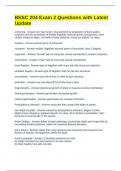BESC 204 Exam 2 Questions with Latest
Update
oomycota - Answer-not "true fungi", characterized by production of thick-walled
oospores and the production of mobile flagellate asexual spores (zoospores), more
closely related to algae, cell walls contain cellulose, nuclei are diploid, no septa
oospore - Answer-sexual spore of oomycete
zoospore - Answer-mobile, flagellate asexual spore of oomycete, have 2 flagella
oogonium - Answer-"female" part of oomycete sexual reproduction; contains oospores
antheridium - Answer-"male" part of oomycete sexual reproduction
tinsel flagella - Answer-type of flagellum with many hair-like structures attached
whiplash flagella - Answer-type of flagellum with no hair-like structures
necrotrophic - Answer-must kill its host in order to gain nutrients
biotrophic - Answer-can only feed off host if the host is alive
thigmotrophic - Answer-directional growth of plant in response to direct stimulation
Direct germination - Answer-germination by hyphal growth
indirect germination - Answer-germination by zoospore formation
Phytophthora infestans - Answer-oomycete that caused late blight of potato
late blight of potato - Answer-caused by phytophthora infestans; began in 1845,
blight=crops collapsing, potatoes liquefy, 15 years, 31% decline in population, "late"
because it occurred late in the season
Anton DeBary - Answer-father of plant pathology; proved late blight was fungus-like by
inoculating healthy potatoes; called the organism Botrytis infestans
germ theory - Answer-states that many diseases are caused by the presence and
actions of specific microrganisms within the body
Koch's postulate - Answer-1) disease symptoms on host
2) isolate microbe from host and put it in pure culture
3) infect healthy host with microbe
, *symptoms from 1 SHOULD match new symptoms*
4) isolate same microbe again from second host
Plasmopora viticola - Answer-oomycete responsible for grape downy mildew,
introduced from the new world
Bordeaux mixture - Answer-discovered and named by professor Millardet, mixture of
copper sulfate and 'lime' (calcium carbonate, calcium oxide, calcium hydroxide), named
Brodeaux for the the region it was used in (to fight ringworm)(studied at univ. of
bordeaux), protected grapes
obligate pathogen/obligate biotroph - Answer-can only complete their development on a
living host
robigus - Answer-Roman rust god, red
wheat rust life cycle - Answer-stage 0: spermagonia
stage 1: aeciospores - transfer spores (can only infect wheat)
----------------------------------------
stage 2: urediospores - repeating spores
stage 3: teliospores - meiosis in early spring
stage 4: basidiospores - transfer spores (can only infect barberry
stage 0: spermagonia and spermatia - Answer-results form infection by haploid
basidiospore, carried out on barbarry, (n)
stage 1: aecium and aeciospores - Answer-also on barbarry, dikaryotization, spores are
single-celled, these spores are transfer spores - have to move to wheat, (n+n)
stage 2: uredinium and urediniospores - Answer-repeating spores - are able to infect
host on which they are formed, usually one-celled, germinate quickly - short lived, (n+n),
use appressorium - snakelike hyphae
stage 3: telium and teliospores - Answer-(n+n/2n), from uredinium if present, site of
karyogamy - resistant, germinate by forming basidiums and basidiospores
stage 4: basidia and basidiospores - Answer-meiosis, septa formed creating haploids,
germinate directly or indirectly, transfer spores
coffee rust - Answer-Hemileia vastatrix, discovered by Rev. Miles Berkeley, 1869,
soybean rust - Answer-1902, two rusts - Phakopsora pahyrhizi(most virulent) and P.
meibomiae, kudzu is alternate host
stinking smut - Answer-plant disease that is seed borne, affects wheat, Telletia foetida,
gave way to gingerbread and gingerbread man




